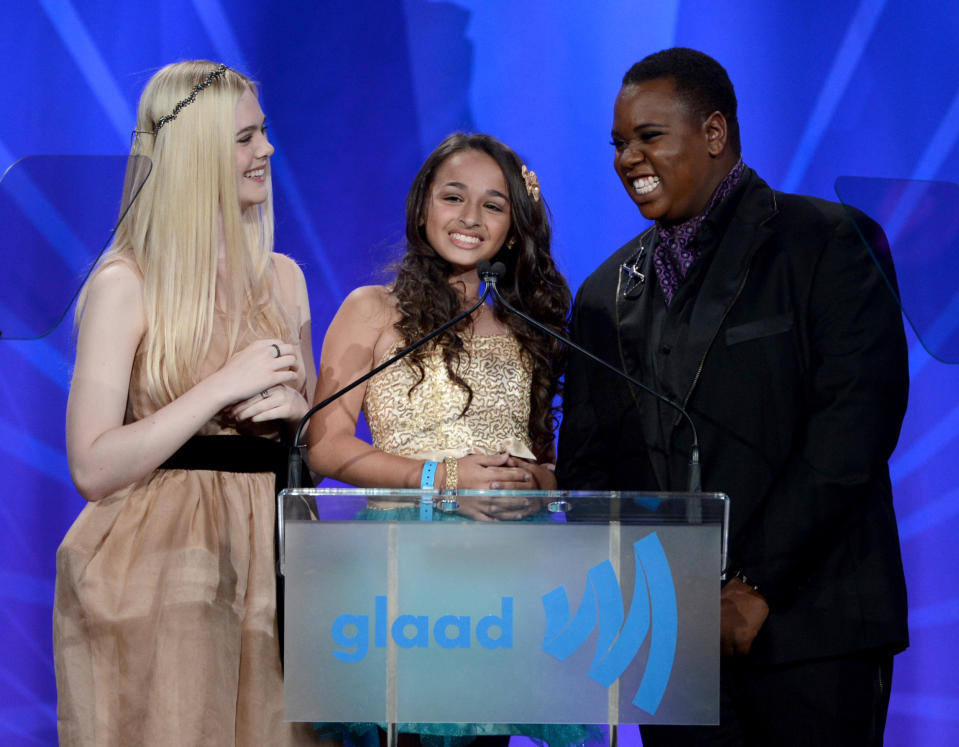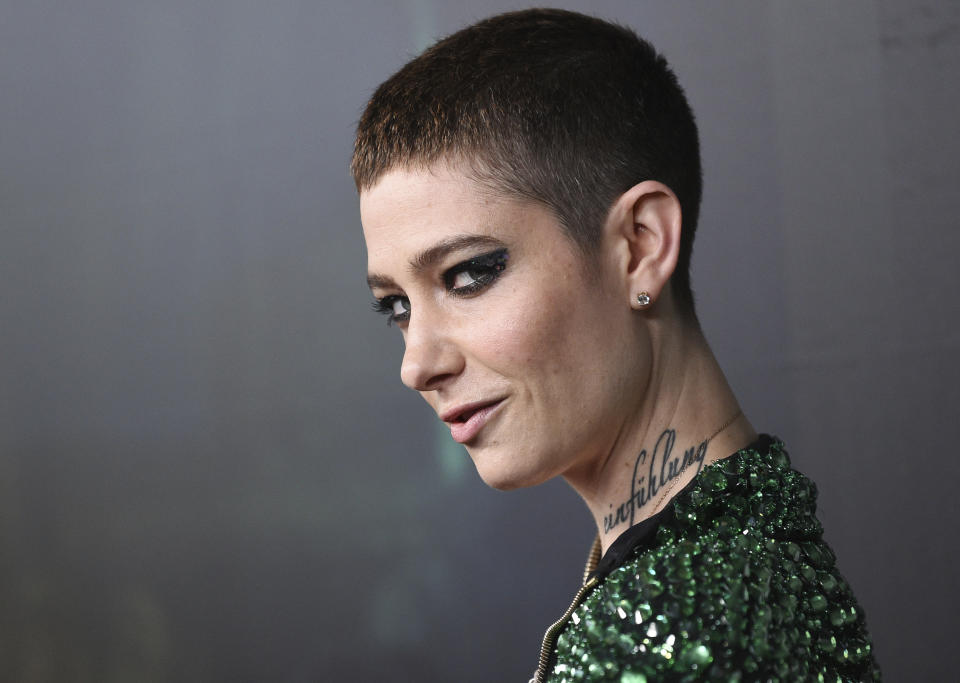Jazz Jennings, Chaz Bono and Caitlyn Jenner: How the last decade changed the way we see gender

This past decade has brought about a seismic shift in how Americans view gender and gender expression — particularly when it comes to the ever-expanding awareness of what it means to be transgender.
For this you can give at least partial credit to the many powerful pop-culture moments over the years — from the coming out of Caitlyn Jenner and Chelsea Manning to the premiere of television shows like Transparent and Pose.
And while it’s impossible to pick just one as having had the most cultural impact, it is worth noting that there’s been one young woman whose very public, very proud gender transition has been a consistent influencer now for more than a decade: Jazz Jennings.
Jazz is the Florida teen, reality-show star and transgender activist who first leapt into public view at age 6, during a candid and groundbreaking 20/20 interview with Barbara Walters in 2007. And she remains squarely in the public eye today, allowing a massive and devoted audience to trail her and her loving family — first through a 2011 Oprah Winfrey Network documentary and, as of 2015, on the TLC reality series, I Am Jazz — as she goes through pretty much every milestone of adolescence, from dating and dances to college acceptance, not to mention her most personal experience of all: her gender-reassignment surgery.
The show averages over one million viewers per episode, which equals one immense social impact — and that’s not even counting the other ways Jazz has gotten her story out there over the years.
“It's pretty surreal, to be honest,” Jazz, now 19, tells Yahoo Lifestyle about her unique and lengthy experience in public view.
“When we first decided to share our story, we had no idea how huge of an impact our family would have on so many other lives,” she adds, “so I think just seeing the way culture has shifted around gender, and people being more open and accepting to transgender people — it's just really cool to know that we played a part in all of that.”
The Jennings family first went public, through a local newspaper, in response to Jazz’s kindergarten not allowing her to use female pronouns or wear dresses; the story was picked up nationally, and then snowballed from there to ABC and beyond. Her story was, for many Americans, their first time hearing about anyone being transgender — especially someone so young. “I think the main reason why we wanted to do it was just help others who were like me, transgender kids out there, to help them realize that they're not alone in their journey and that there's others like them,” Jazz recalls.
“When our family first shared our story, there really weren't any transgender kids in the public, or there weren't many who heard of transgender kids. And now I feel like you'll hear about trans kids more frequently,” she adds. “I think that shift is really amazing to see, because people are finally able to step out of the shadows and be their true authentic selves.”
Her story has taken many other forms, as well, certainly widening its impact. In the years since Jazz spoke with Walters as a kindergartener, she returned as a braces-wearing tween for a follow-up in 2012 (and has sat for many other interviews as well), and she has co-written a children’s picture book, called I Am Jazz, as well as a memoir, Being Jazz: My Life as a (Transgender) Teen.
She has also become a YouTube sensation with 675,000 followers and blossomed as a reality star, first on the OWN Network’s I Am Jazz: A Family in Transition, and then again on TLC’s I Am Jazz, which enters its 6th season on Jan. 28. She has starred in a short film, “Denim,” about a trans teen who gets outed at school, and has conquered social media, amassing 961,000 followers on Instagram, where she’s shared everything from her post-surgery debut in a swimsuit to news that she deferred her acceptance to Harvard. She has also starred in a commercial, was named one of Time magazine’s most influential teens of 2014 (and again in 2015), and became the youngest honoree ever to make both Out’s “Out 100” and the Advocate’s “40 under 40.”
“It is a lot of pressure,” she admits.

But the still-rippling impact of her ongoing journey has been “unprecedented and groundbreaking,” explains Nick Adams, director of transgender representation at GLAAD, which advocates for fair and accurate LGBTQ media representation.
"I think that Jazz and her family's decision to share so many details of her life as a young transgender girl going through both a social and medical transition have had impact in two ways,” Adams says. “It has allowed Americans who think they’ve never met someone who's transgender to get to know Jazz’s family and to know what it means to love and support your transgender child. And for families who do have transgender children, it's given them hope and critical information about what their journey may be like as they support their child."
Now, as we slide out of the 2010s and into 2020, hope on the transgender equality front is needed perhaps more than ever. While media visibility has reached an encouraging high point, the Trump administration has triggered a transgender rights rollback in a slew of areas, from serving in the military to receiving medical treatment. And — as of Dec. 7 — 2019 got the dismal distinction of becoming the deadliest year on record for transgender Americans. That date is when Nikki Kuhnhausen, 18, was found dead in in Vancouver, Wash., becoming the 27th transgender homicide victim of the year.
Jazz posted about Nikki’s murder on Facebook, saying, simply, “She was only 18....the murders must stop.”
So does visibility really have the power to bring about change? Adams believes it does.
“Backlash has grown against many different marginalized groups of people,” he says, but it is “often fueled by stoking people’s fears and ignorance about people different from them. So, I believe that the more we can have visibility, the more we can combat that ignorance and that fear — and for people who have the safety and privilege to do that, I think it can make a difference. They can change hearts and minds.”
Let’s take a look back at some moments during the past decade that aimed to do just that.
Gender gets fluid
"The last decade has seen a tremendous increase in visibility for people who are transgender, and media representations are starting to portray trans people in more real and authentic ways,” Adams says. “Growing cultural awareness about people who are trans has also sparked more conversations among non-trans people about the rigid and outdated gender-based expectations that affect all of us.”

Some of those conversations have come out of basic yet groundbreaking moments — when Tide featured a stay-at-home dad in a 2011 commercial, for example, and when Target announced in 2015 that it would eliminate separate “boys” and “girls” sections for toys and bedding. Those seemingly tame moments caused both celebration and outrage over the collective message: The time for gender stereotypes had come to an end.
Those gave way to bigger, bolder milestones in gender fluidity — such as Billy Porter wearing a gown on the 2019 Oscars red carpet, and Jonathan Van Ness (who would soon announce he was nonbinary) making a similar move at the 2019 Emmy Awards.

Back in 2015, Miley Cyrus noted that she does not “relate to being boy or girl,” while Amandla Stenberg opted for “they/them” singular pronouns in 2016, and nonbinary actor Asia Kate Dillon made history on Billions. Later that same year, Jill Soloway, creator of the groundbreaking Transparent series, came out as nonbinary and embraced the singular “they,” followed by Sam Smith in 2019. It’s no wonder Merriam-Webster declared “they” its word of the year.
The transgender milestone moments, meanwhile, deserve their own timeline.
2010-2012: Passports, Chaz and the DSM-5
In 2010, there were two major moments at the federal government level: President Barack Obama made a high-profile transgender appointment in Washington, D.C., with Amanda Simpson, to the Department of Commerce’s Bureau of Industry and Security — while the State Department made it possible for trans people, no matter what state they lived in and regardless of whether or not they’d had gender reassignment surgery, to change the gender marker on their U.S passports.
Lea T became known as the first transgender supermodel in 2010, while the first of what would soon become a handful of pregnant transgender men to gain notoriety, Thomas Trace Beattie, made it into Guinness World Records in 2010.

Chaz Bono also brought transgender men into the spotlight in 2011, by releasing the documentary of his transition, Becoming Chaz, and by being cast on Dancing With the Stars. In 2012, TV show Glee introduced its first transgender character, Unique. And the American Psychiatric Association announced that its Diagnostic and Statistical Manual of Mental Disorders (DSM) would remove the term, “Gender Identity Disorder,” replacing it with “Gender Dysphoria,” assuring that transgender people “may no longer be subject to a lifelong default diagnosis of their mental health,” noted GLAAD at the time.
2013-2015: Chelsea, Carmen, Leelah, Cait
In 2013, on the eve of her 2013 sentencing for sharing classified military documents with WikiLeaks, Chelsea Manning came out as a transgender woman. That same year would see Laverne Cox starring in Netflix’s hit Orange is the New Black and gracing the cover of Time magazine.
Transparent debuted on Amazon in 2014 — and also that same year, Katie Couric had a public learning moment that helped observers, too: During an interview with Cox and transgender model Carmen Carrera on her daytime talk show, Couric asked a question about the state of Carrera’s genitalia, and was promptly schooled by Cox about that being too invasive. Couric later apologized and admitted she’d learned a valuable lesson.
“That was one of the most important moments in the last decade,” Adams says. “All of journalism woke up and went, ‘Oh my god, we’re not supposed to be asking trans people about their genitals?’”
But 2014 ended with the widely covered, heartbreaking suicide of Ohio transgender teen Leelah Alcorn, which educated people worldwide on the importance of empathetic parents. Her suicide note on Tumblr read, “[My mom] told me that I am wrong. ... If you are reading this, parents, please don’t tell this to your kids. Even if you are Christian or are against transgender people don’t ever say that to someone, especially your kid. That won’t do anything but make them hate them self. That’s exactly what it did to me.”

In 2015, Caitlyn Jenner brought a new level of celebrity to being trans — first by coming out as a transgender woman on a 20/20 interview with Diane Sawyer that pulled in a whopping 17.1 million viewers, and then by appearing in a white corset on the cover of Vanity Fair and kicking off her reality show, I Am Cait, on the E! network.
2016-today: Bathrooms, balls and Stonewall
A backlash — in the form of some politicians using scare tactics to prevent trans people from using the bathroom matching their gender identity — went full steam ahead in places around the country, with North Carolina signing HB2, or the “bathroom bill,” into law in 2016. It required everyone to use the bathroom corresponding with the sex they were originally assigned, but the nationwide protest was so intense that the bill was repealed in 2017.
Also in 2017, transgender activist Ashlee Marie Preston called Caitlyn Jenner a "fraud" in a video that went viral, bringing awareness to the vast diversity of opinions within the trans community. That year also saw greater visibility in terms of trans actors: A Fantastic Woman, starring transgender Chilean actress Daniela Vega, won the Academy Award for Best Foreign Language Film. The groundbreaking TV series Pose — featuring the largest cast ever of transgender actors in scripted roles and written by trans activist Janet Mock — debuted on FX in 2018, fictionalizing the queer ballroom culture of the ’80s and ’90s that was first brought to light by the documentary Paris Is Burning, while Supergirl season 4 starred actress Nicole Maines as TV’s first trans superhero, Nia Nal.
While Pose was bringing acceptance, visibility and fame to so many, however, the rate of murders of trans women, particularly black trans women, was climbing, sparking protests and vigils in cities across the country. The collective grief was oddly juxtaposed with the excitement of Pride Month and the 50th anniversary of Stonewall in June.
As Adams says today, “We still have a long way to go before people can be true to themselves without fear of discrimination and violence.”
Still, in spite of the continuing threat against trans people, Jazz says she remains ever faithful to the power of representation. “I definitely think visibility has a lot of value,” she says. “I think the more people hear about transgender individuals, the more they can be open to accepting us for who we are. And I just think it needs to continue.”
Read more from Yahoo Lifestyle:
Texas mom and dad locked in battle over child’s gender identity: What happens when parents disagree?
Follow us on Instagram, Facebook and Twitter for nonstop inspiration delivered fresh to your feed, every day.



